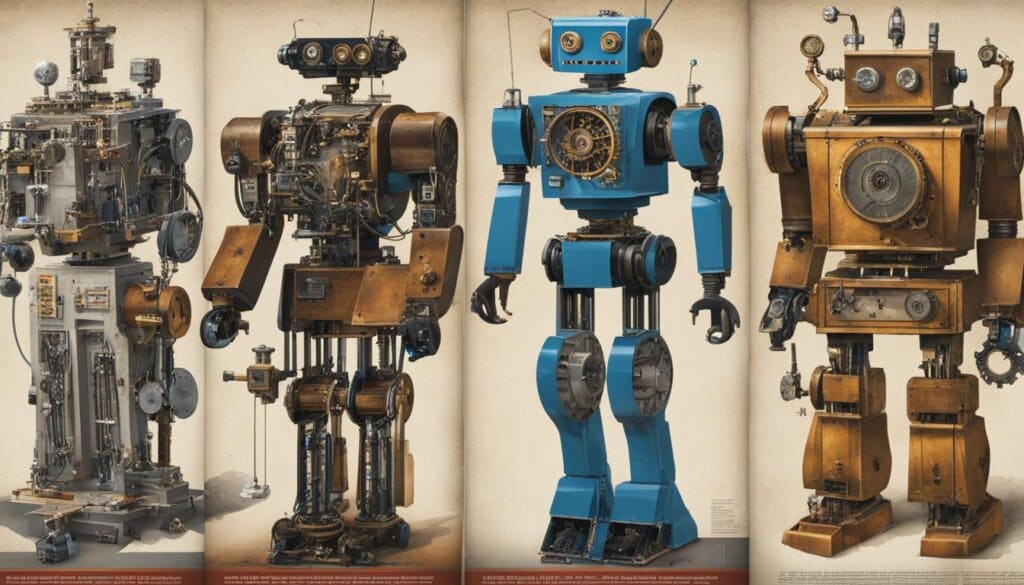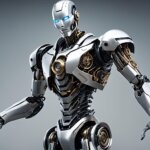Table of Contents
Robotics is an exciting field that combines engineering, computer science, and artificial intelligence to create intelligent machines known as robots. These robots are designed to assist humans in various tasks and industries, making our lives easier and more efficient.
But what exactly is robotics? In simple terms, robotics involves the conception, design, manufacture, and operation of robots. It encompasses a wide range of disciplines, including computer science, electrical engineering, and mechanical engineering, all working together to bring robots to life.
Currently, robotics is experiencing several intriguing trends that are shaping its future. From advancements in artificial intelligence to the rise of collaborative robots, the field is constantly evolving. It’s important to stay up-to-date with the latest developments to fully grasp the potential and possibilities offered by robotics.
In this article, we will explore the definition of robotics in more detail, delve into how robots function, delve into the history of robotics, and discuss the key trends shaping the field. We will also explore the diverse applications of robotics across different industries and examine the role of machine learning in enhancing robot capabilities. Lastly, we will consider the pros and cons of robotics to gain a comprehensive understanding of its impact.
So, join us as we embark on this exciting journey into the world of robotics, where innovation and technology merge to create the robots of the future.
How Do Robots Function?
Robots can function in different ways depending on their design and purpose. Two main categories of robots are independent robots and dependent robots.
Independent Robots
Independent robots, also known as autonomous robots, have the ability to operate without human control. These robots are programmed with advanced algorithms and artificial intelligence that enable them to perform tasks that are dangerous, mundane, or even impossible for humans. They can navigate their surroundings, make decisions, and complete complex operations with accuracy and efficiency. Independent robots are often used in industries such as manufacturing, logistics, and space exploration.
Dependent Robots
Dependent robots, as the name suggests, rely on interaction with humans to enhance their actions. They are designed to complement human skills and abilities, extending capabilities and providing support in various tasks. One example of a dependent robot is a prosthetic limb controlled by the human mind. These robots work in collaboration with their human counterparts to improve mobility, functionality, and quality of life. Dependent robots have applications in fields such as healthcare, rehabilitation, and assistive technology.
The main components of a robot are integral to its functioning:
- Control System: The control system is the brain of the robot, responsible for processing information and executing commands.
- Sensors: Sensors enable robots to perceive and gather data about their environment. They can include cameras, microphones, touch sensors, and proximity sensors, among others.
- Actuators: Actuators are responsible for the physical movements and actions of the robot. They convert energy into motion and can include motors, pneumatics, or hydraulics.
- Power Supply: The power supply provides the necessary energy to operate the robot. It can be in the form of batteries, power cables, or other sources of electrical power.
- End Effectors: End effectors are the tools or attachments at the end of a robot’s arm or chassis. They enable robots to interact with their surroundings, perform specific tasks, or manipulate objects.
These components work together harmoniously to enable a robot’s functionality and accomplish its designated tasks.
History and Evolution of Robotics
The history of robotics can be traced back to ancient civilizations, with early examples of automata found in Greek mythology and Chinese folklore. These early mechanical creations sparked fascination and curiosity about the possibility of designing and building machines capable of performing tasks autonomously. However, it was not until the 1950s that the development of industrial robots marked a significant milestone in the field of robotics.
Industrial robots revolutionized manufacturing settings by introducing automation to various tasks, such as welding, painting, and assembly. These early robots were programmed to carry out repetitive and labor-intensive tasks, freeing human workers from hazardous and monotonous jobs. Industrial robots not only increased productivity but also improved efficiency and quality in production lines.
Advancements in technology, particularly in microprocessors, sensors, and artificial intelligence, have played a significant role in the evolution of robotics. These advancements have made robots more intelligent, flexible, and capable of adapting to different environments and tasks. The integration of sensors allows robots to perceive and interact with their surroundings, enabling them to navigate complex environments and work collaboratively with humans.
Today, robotics has expanded beyond the manufacturing sector and has become an integral part of various industries, including healthcare, agriculture, transportation, and space exploration. The application of robotics in healthcare has led to breakthroughs in surgeries, rehabilitation, and diagnostics, significantly improving patient outcomes. In agriculture, robots are used for tasks like planting, harvesting, and monitoring crops, enhancing efficiency and reducing labor costs.
Robots are also making significant contributions to space exploration, with specialized robots designed for extraterrestrial missions to gather data and perform experiments in environments too harsh for humans. Additionally, robotics is driving advancements in autonomous vehicles, such as self-driving cars and drones, which are poised to transform transportation systems in the near future.

The history and evolution of robotics showcases the continuous advancements that have shaped the field, enabling robots to become indispensable assets across a wide range of industries. With ongoing research and technological breakthroughs, the future of robotics holds even greater potential for innovation and societal impact.
Key Trends in Robotics
In recent years, the field of robotics has witnessed several key trends that have significantly shaped its landscape. From advancements in artificial intelligence to the emergence of collaborative robots, these trends have paved the way for groundbreaking applications in various industries.
Artificial Intelligence in Robotics
Artificial intelligence (AI) and machine learning have played a critical role in enabling robots to perform complex tasks and make intelligent decisions. By leveraging AI algorithms, robots can analyze vast amounts of data, adapt to dynamic environments, and interact more seamlessly with humans.
Collaborative Robots
Collaborative robots, also known as cobots, are designed to work alongside humans. These robots prioritize safety and have built-in sensors that allow them to detect human presence, ensuring a safe and productive working environment. Cobots enhance human-robot collaboration, augmenting productivity and efficiency in various industries.
Soft Robotics
Soft robotics focuses on developing robots made from soft, flexible materials that can mimic the movements and adaptability of living organisms. These robots have the ability to interact with delicate objects and navigate complex environments with ease. Soft robotics has significant implications in industries such as healthcare and exploration, where gentle interactions are required.
Swarm Robotics
Swarm robotics explores the concept of large groups of simple robots working together to accomplish complex tasks. Inspired by the behavior of social insects, swarm robots can effectively tackle tasks like search-and-rescue missions, environmental monitoring, and disaster response. The collective intelligence of swarm robots enables them to adapt and solve problems efficiently.
Autonomous Vehicles
Autonomous vehicles have revolutionized the transportation industry. From self-driving cars to unmanned drones, these vehicles leverage robotics and AI technologies to navigate without human intervention. Autonomous vehicles are poised to transform various sectors, including logistics, delivery services, and even space exploration.
Medical Robotics
In the field of medicine, robotics has paved the way for innovative techniques and interventions. Medical robots assist surgeons in performing precise and minimally invasive procedures, enhancing patient outcomes and reducing recovery times. From surgical robots to robotic prosthetics, medical robotics continues to push the boundaries of medical innovation.
Humanoid Robots
Humanoid robots are designed to resemble and mimic human movements. These robots have gained significant attention in research, entertainment, and personal assistance. Humanoid robots have the potential to collaborate and interact with humans in a natural and intuitive way, making them ideal for various applications.
Augmented Reality in Robotics
Augmented reality (AR) has emerged as a promising technology in the field of robotics. AR overlays virtual information onto the real world, enabling robots to perform tasks with enhanced perception and accuracy. This opens up new possibilities for training, maintenance, and remote assistance in industries such as manufacturing and healthcare.
These key trends in robotics represent the cutting-edge advancements that are shaping the future of automation. With the integration of AI, collaborative robots, soft robotics, swarm robotics, autonomous vehicles, medical robotics, humanoid robots, and augmented reality, we can expect exciting developments and transformative applications across various industries.
Robotics Applications
Robotics has revolutionized various industries through its diverse applications. From enhancing productivity in manufacturing to aiding in medical procedures, robots have become indispensable in many sectors. Let’s explore some of the key areas where robots are making a significant impact:
Industrial Robots
Industrial robots are extensively utilized in manufacturing and warehouse environments. These robots excel in tasks such as welding, painting, and material handling, where they offer precision and efficiency. By automating repetitive and labor-intensive processes, industrial robots streamline production and improve overall operational effectiveness.
Service Robots
In fields such as hospitality, healthcare, and household chores, service robots play a crucial role in assisting humans. These robots serve customers, provide care to patients, and even help with daily household tasks. With their interactive and versatile features, service robots enhance customer experiences and simplify everyday life.
Medical Robots
In the healthcare industry, medical robots have emerged as valuable assets. They assist surgeons during complex procedures, improving precision and reducing invasive measures. Additionally, medical robots aid in patient rehabilitation and support diagnostics, contributing to advancements in medical treatments and patient care.
Autonomous Vehicles
Autonomous vehicles, including self-driving cars and drones, are transforming the transportation landscape. These vehicles utilize robotics and AI technologies to navigate and operate without human intervention. Autonomous vehicles offer safer and more efficient transportation options, paving the way for a future of enhanced mobility.
Humanoid Robots
Humanoid robots are designed to replicate human movements and interactions. They find applications in various fields, including research, entertainment, and personal assistance. Humanoid robots have the potential to perform tasks that require human-like dexterity, making them valuable in areas such as complex surgeries, social interactions, and immersive entertainment experiences.
Agricultural Robots
In the agricultural industry, robots assist with farming tasks, thereby increasing efficiency and productivity. These robots are used for activities such as planting, harvesting, and crop monitoring. By incorporating robotics into agriculture, farmers can optimize their operations, reduce manual labor, and ensure sustainable practices.
Exploration and Space Robots
Exploration and space robots are instrumental in missions that involve exploring distant and harsh environments. These robots are designed to withstand extreme conditions and perform tasks such as collecting samples, conducting experiments, and facilitating scientific research. Their ability to navigate and operate in space and other challenging terrains expands our understanding of the universe and drives technological advancements.
Defense and Military Robots
Defense and military robots play a crucial role in surveillance, bomb disposal, and search-and-rescue missions. These robots operate in high-risk situations, enabling military personnel to mitigate potential dangers. Defense and military robots enhance situational awareness, protect human lives, and contribute to national security.
Educational Robots
Educational robots are designed to facilitate learning and skill development. They serve as interactive tools in classrooms and educational institutions, fostering engagement and knowledge acquisition. Educational robots encourage students to explore robotics, programming, and STEM concepts, nurturing creativity and critical thinking.
Entertainment Robots
Robots have also found their way into the entertainment industry, providing captivating and interactive experiences. Entertainment robots can perform various tasks, from storytelling and dancing to interacting with audiences in theme parks and entertainment venues. These robots combine technology and creativity to deliver unique and engaging entertainment experiences.
In conclusion, the wide range of applications for robotics demonstrates its immense potential in transforming industries and improving human lives. From industrial settings to outer space, robots continue to redefine what is possible and push the boundaries of innovation.
Machine Learning in Robotics
Machine learning plays a crucial role in robotics, particularly in robot learning. Robot learning focuses on techniques that enable robots to acquire new knowledge or skills through machine learning algorithms. By leveraging machine learning, robots can continuously enhance their performance and adapt to evolving circumstances.
One key aspect of machine learning in robotics is computer vision. Computer vision allows robots to perceive and interpret visual information from their environment using sensors and algorithms. This enables them to navigate obstacles, recognize objects, and interact with their surroundings effectively.
Another important technique is self-supervised learning. Unlike traditional supervised learning where robots need explicit training data, self-supervised learning enables robots to learn tasks without specific instructions. Through self-supervised learning algorithms, robots can explore and understand their environment by leveraging inherent structures and features within the data they collect.
Imitation learning involves teaching robots to replicate human behavior or actions. This technique is particularly useful for tasks that require precision and mimicry. By observing and imitating human actions, robots can acquire complex skills and perform tasks that traditionally required human intervention.
Assistive robotics is an area that benefits greatly from machine learning. Through machine learning algorithms, assistive robots can understand and adapt to the needs of individuals requiring assistance in their daily tasks. This empowers people with physical disabilities to regain independence and improve their quality of life.
Reinforcement learning takes a trial-and-error approach to teach robots how to perform challenging tasks. By providing feedback in the form of rewards or penalties, robots can optimize their actions and behavior over time. This iterative learning process enables robots to improve their decision-making capabilities and achieve higher levels of performance.
Overall, machine learning empowers robots to continuously learn, adapt, and perform tasks with increasing complexity. It enables the development of intelligent robotic systems with enhanced capabilities, contributing to advancements in fields such as healthcare, manufacturing, transportation, and beyond.
| Machine Learning Techniques in Robotics | Applications |
|---|---|
| Computer Vision | Object recognition, autonomous navigation, visual inspection |
| Self-Supervised Learning | Exploration and understanding of the environment, adaptive behavior |
| Imitation Learning | Precision tasks, human-like behavior, skill acquisition |
| Assistive Robotics | Support for individuals with disabilities, daily task assistance |
| Reinforcement Learning | Challenging task optimization, decision-making improvement |
Pros and Cons of Robotics
Robotics has numerous advantages that make it a valuable technology in various industries. One significant benefit is the enhanced safety it brings by eliminating the need for human workers to be exposed to hazardous environments. Robots are perfectly suited to handle tasks that pose risks to human health and safety, ensuring that no harm comes to workers.
Another advantage of robotics is the boost in productivity it provides. Unlike human workers who require breaks and rest periods, robots can work continuously without any interruptions. This ensures constant and efficient performance, leading to increased productivity levels and faster completion of tasks.
Accuracy is another key strength of robotics. With advanced sensors and precision engineering, robots can perform tasks with exceptional accuracy and consistency. They are not prone to human errors or fatigue, resulting in higher quality outputs and fewer mistakes.
However, it’s important to acknowledge the potential drawbacks of robotics. One significant concern is the initial cost of implementing robotic systems. While the long-term benefits may outweigh the investment, the upfront expenses can be a barrier for some businesses. Additionally, the rise of robotics can lead to job displacement, as some roles previously performed by humans may be taken over by robots. This raises questions surrounding employment and the need for retraining for those affected.
When evaluating the applications of robotics, it is crucial to consider both the advantages and disadvantages. While robotics offers improved safety, enhanced productivity, and precise performance, the costs and potential job displacement should be taken into account. By weighing these factors, businesses can make informed decisions about incorporating robotics into their operations.
FAQ
What is robotics?
Robotics is a branch of engineering and computer science that involves the conception, design, manufacture, and operation of robots. Its objective is to create intelligent machines that can assist humans in various tasks.
How do robots function?
Robots can function independently or dependently. Independent robots are autonomous and can operate without human control, while dependent robots interact with humans to enhance their actions.
What are the main components of a robot?
The main components of a robot include a control system, sensors, actuators, power supply, and end effectors. These components work together to enable a robot’s functionality.
What is the history and evolution of robotics?
The history of robotics can be traced back to ancient civilizations, but the development of industrial robots in the 1950s marked a significant milestone. Over time, robots have become more intelligent and capable due to advancements in technology.
What are the key trends in robotics?
Some key trends in robotics include artificial intelligence, collaborative robots, soft robotics, swarm robotics, autonomous vehicles, medical robotics, humanoid robots, and augmented reality.
What are the applications of robotics?
Robotics has diverse applications across various industries, including manufacturing, healthcare, transportation, agriculture, exploration and space, defense and military, education, and entertainment.
How does machine learning contribute to robotics?
Machine learning plays a crucial role in robotics, enabling robots to acquire new knowledge or skills, perceive and navigate their environment, replicate human behavior, and carry out challenging tasks through trial-and-error techniques.
What are the pros and cons of robotics?
Robotics offers advantages such as improved safety, enhanced productivity, and high accuracy. However, there are also potential drawbacks, such as the initial cost of implementation and the potential for job displacement.













